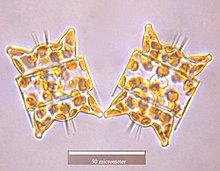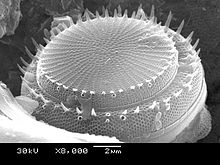Taxonomy of diatoms

Genera and species
An estimated 20,000
Classes and orders
Overview
For many years the diatoms—treated either as a class (Bacillariophyceae) or a phylum (Bacillariophyta)—were divided into just 2 orders, corresponding to the centric and the pennate diatoms (
Today (writing at mid 2020) it is recognised that the 1990 system of Round et al. is in need of revision with the advent of newer molecular work, however the best system to replace it is unclear, and current systems in widespread use such as AlgaeBase, the World Register of Marine Species and its contributing database DiatomBase, and the system for "all life" represented in Ruggiero et al., 2015, all retain the Round et al. treatment as their basis, albeit with diatoms as a whole treated as a class rather than division/phylum, and Round et al.'s classes reduced to subclasses, for better agreement with the treatment of phylogenetically adjacent groups and their containing taxa. (For references refer the individual sections below).
One proposal, by Linda Medlin and co-workers commencing in 2004, is for some of the centric diatom orders considered more closely related to the pennates to be split off as a new class, Mediophyceae, itself more closely aligned with the pennate diatoms than the remaining centrics. This hypothesis—later designated the Coscinodiscophyceae-Mediophyceae-Bacillariophyceae, or Coscinodiscophyceae+(Mediophyceae+Bacillariophyceae) (CMB) hypothesis—has been accepted by D.G. Mann among others, who uses it as the basis for the classification of diatoms as presented in Adl. et al.'s series of syntheses (2005, 2012, 2019), and also in the Bacillariophyta chapter of the 2017 Handbook of the Protists edited by Archibald et al., with some modifications reflecting the apparent non-monophyly of Medlin et al. original "Coscinodiscophyceae". Meanwhile, a group led by E.C. Theriot favours a different hypothesis of phylogeny, which has been termed the structural gradation hypothesis (SGH) and does not recognise the Mediophyceae as a monophyletic group, while another analysis, that of Parks et al., 2018, finds that the radial centric diatoms (Medlin et al.'s Coscinodiscophyceae) are not monophyletic, but supports the monophyly of Mediophyceae minus Attheya, which is an anomalous genus. Discussion of the relative merits of these conflicting schemes continues by the various parties involved.[10][11][12][13]
Round et al., 1990
Based on the fact that pennate diatoms either do or do not have a longitudinal groove in the valve, called a raphe,[14] a 1990 classification by Round, Crawford & Mann[3] divides the diatoms (as Bacillarophyta) into three classes, centric (22 orders); pennate without a raphe (12 orders); and pennate with a raphe (11 orders), as follows:[15]

Isthmia nervosaIsthmia nervosa

Odontella aurita

Stephanodiscus hantzschii

- Phylum Bacillarophyta (diatoms)
- Class Coscinodiscophyceae Round & R.M.Crawford (centric diatoms)
- Subclass Biddulphiophycidae Round & R.M.Crawford
- Anaulales Round & R.M.Crawford
- BiddulphialesKrieger
- Hemiaulales Round & R.M.Crawford
- Triceratiales Round & R.M.Crawford
- Subclass Chaetocerotophycidae Round & R.M.Crawford
- Chaetocerotales Round & R.M.Crawford
- Leptocylindrales Round & R.M.Crawford
- Subclass Corethrophycidae Round & R.M.Crawford
- Corethrales Round & R.M.Crawford
- Subclass Coscinodiscophycidae Round & R.M.Crawford
- Arachnoidiscales Round
- Asterolamprales Round
- Aulacoseirales R.M.Crawford
- Chrysanthemodiscales Round
- Coscinodiscales Round
- Ethmodiscales Round
- Melosirales R.M.Crawford
- Orthoseirales R.M.Crawford
- Paraliales R.M.Crawford
- Stictocyclales Round
- Stictodiscales Round & R.M.Crawford
- Subclass Cymatosirophycidae Round & R.M.Crawford
- Cymatosirales Round & R.M.Crawford
- Subclass Lithodesmiophycidae Round & R.M.Crawford
- Lithodesmiales Round & R.M.Crawford
- Subclass Rhizosoleniophycidae Round & R.M.Crawford
- Rhizosoleniales Silva
- Subclass Thalassiosirophycidae Round & R.M.Crawford
- Thalassiosirales Glezer & Makarova
- Class Fragilariophyceae Round (pennate diatoms without a raphe (araphids))
- Subclass Fragilariophycidae Round
- Ardissoneales Round
- Climacospheniales Round
- Cyclophorales Round & R.M.Crawford
- Fragilariales P.C.Silva
- Licmophorales Round
- Protoraphidales Round
- Rhabdonematales Round & R.M.Crawford
- Rhaphoneidales Round
- StriatellalesRound
- Tabellariales Round
- Thalassionematales Round
- Toxariales Round
- Class BacillariophyceaeHaeckel, 1878, emend. D.G.Mann (pennate diatoms with a raphe (raphids))
- Subclass Bacillariophycidae D.G.Mann
- Achnanthales P.C.Silva
- BacillarialesHendey
- Cymbellales D.G.Mann
- Dictyoneidales D.G.Mann
- Lyrellales D.G.Mann
- Mastogloiales D.G.Mann
- Naviculales Bessey
- Rhopalodiales D.G.Mann
- Surirellales D.G.Mann
- Thalassiophysales D.G.Mann
- Subclass Eunotiophycidae D.G.Mann
- Eunotiales P.C.Silva
Medlin & Kaczmarska, 2004
An alternate classification for the diatoms based on molecular phylogeny was proposed by Medlin & Kaczmarska in 2004, as follows.[16] Medlin and co-workers erected a new class, Mediophyceae (which could be re-ranked a subclass if diatoms as a whole are ranked as a class rather than a phylum) for the "polar centric" diatoms, which they consider to be more closely related to the pennate rather than to other centric diatoms, a concept which has been followed or further adapted by some (e.g. Adl et al., 2019, see below), but not all subsequent workers at this time.
- Phylum Bacillariophyta (diatoms)
- Subphylum Coscinodiscophytina
- Class Coscinodiscophyceae ("radial centrics")
- Subphylum Bacillariophytina
- Class Mediophyceae ("polar centrics")
- Class Bacillariophyceae(pennate diatoms)
Ruggiero et al., 2015
In the treatment for "all life" (down to order, extant taxa only) by Ruggiero et al., 2015,
- Superphylum Heterokonta(heterokonts: Ochrophyta plus other phyla))
- Phylum Ochrophyta(diatoms plus other classes)
- Class Bacillariophyceae (diatoms)
- Subclass Bacillariophycidae
- Subclass Coscinodiscophycidae
- Anaulales
- Arachnoidiscales
- Asterolamprales
- Aulacoseirales
- Biddulphiales
- Chaetocerotales
- Chrysanthemodiscales
- Corethrales
- Coscinodiscales
- Cymatosirales
- Ethmodiscales
- Hemiaulales
- Leptocylindrales
- Lithodesmiales
- Melosirales
- Orthoseirales
- Paraliales
- Rhizosoleniales
- Stictocyclales
- Stictodiscales
- Thalassiosirales
- Triceratiales
- Subclass Fragilariophycidae
- Phylum
Adl et al., 2019
Following earlier versions in the treatments of Adl et al. 2005 and 2012,[18][19] D.G. Mann, in Adl et al. 2019,[20] presented his most recent classification of diatoms as follows, while noting: "This revision reflects numerous advances in the phylogeny of the diatoms over the last decade. Due to our poor taxon sampling outside of the Mediophyceae and pennate diatoms, and the known and anticipated diversity of all diatoms, many clades appear at a high classification level (and the higher level classification is rather flat)." This classification treats diatoms as a phylum (Diatomeae/Bacillariophyta), accepts the class Mediophyceae of Medlin and co-workers, introduces new subphyla and classes for a number of otherwise isolated genera, and re-ranks a number of previously established taxa as subclasses, but does not list orders or families. Inferred ranks have been added for clarity (Adl. et al. do not use ranks, but the intended ones in this portion of the classification are apparent from the choice of endings used, within the system of botanical nomenclature employed).
- Clade DiatomistaDerelle et al. 2016, emend. Cavalier-Smith 2017 (diatoms plus a subset of other ochrophyte groups)
- Phylum Diatomeae Dumortier 1821 [= BacillariophytaHaeckel 1878] (diatoms)
- Subphylum Leptocylindrophytina D.G. Mann in Adl et al. 2019
- Class Leptocylindrophyceae D.G. Mann in Adl et al. 2019 (Leptocylindrus, Tenuicylindrus)
- Class Corethrophyceae D.G. Mann in Adl et al. 2019 (Corethron)
- Subphylum Ellerbeckiophytina D.G. Mann in Adl et al. 2019 (Ellerbeckia)
- Subphylum Probosciophytina D.G. Mann in Adl et al. 2019 (Proboscia)
- Subphylum Melosirophytina D.G. Mann in Adl et al. 2019 (Aulacoseira, Melosira, Hyalodiscus, Stephanopyxis, Paralia, Endictya)
- Subphylum Coscinodiscophytina Medlin & Kaczmarska 2004, emend. (Actinoptychus, Coscinodiscus, Actinocyclus, Asteromphalus, Aulacodiscus, Stellarima)
- Subphylum Rhizosoleniophytina D.G. Mann in Adl et al. 2019 (Guinardia, Rhizosolenia, Pseudosolenia)
- Subphylum Arachnoidiscophytina D.G. Mann in Adl et al. 2019 (Arachnoidiscus)
- Subphylum Bacillariophytina Medlin & Kaczmarska 2004, emend.
- Class Mediophyceae Jouse & Proshkina-Lavrenko in Medlin & Kaczmarska 2004
- Subclass Chaetocerotophycidae Round & R.M. Crawford in Round et al. 1990, emend.
- Subclass Lithodesmiophycidae Round & R.M. Crawford in Round et al. 1990, emend.
- Subclass Thalassiosirophycidae Round & R.M. Crawford in Round et al. 1990
- Subclass Cymatosirophycidae Round & R.M. Crawford in Round et al. 1990
- Subclass Odontellophycidae D.G. Mann in Adl et al. 2019
- Subclass Chrysanthemodiscophycidae D.G. Mann in Adl et al. 2019
- Class Biddulphiophyceae D.G. Mann in Adl et al. 2019
- Subclass Biddulphiophycidae Round and R.M. Crawford in Round et al. 1990, emend.
- Biddulphiophyceae incertae sedis (Attheya)
- Class BacillariophyceaeHaeckel 1878, emend.
- Bacillariophyceae incertae sedis (Striatellaceae)
- Subclass Urneidophycidae Medlin 2016
- Subclass Fragilariophycidae Round in Round, Crawford & Mann 1990, emend.
- Subclass Bacillariophycidae D.G. Mann in Round, Crawford & Mann 1990, emend.
- Phylum Diatomeae Dumortier 1821 [=
Others
Another systematic approach to classification was proposed in 1995, the Hoek, Mann and Jahns system.[21] Previous versions of the Adl et al., 2019 classification appeared in Adl et al. 2005 and Adl et al. 2012,[18][19] also in the chapter "Bacillariophyta" by Mann, Crawford & Round in the 2017 Handbook of the Protists edited by Archibald et al.,[22] in which some groups later named as formal taxa are listed under informal names (leptocylindrids, corethrids, melosirids, etc.).
References
- S2CID 30911529.
- ISBN 978-0-08-053441-1. Retrieved 13 November 2013.
- ^ ]
- ISBN 0-948737-25-5.[page needed]
- S2CID 37684109.
- .
- ^ The World Register of Marine Species lists 1,356 diatom genus names from all habitats as at July 2020, of which 1,248 are "accepted".
- ^ Queries to the World Register of Marine Species, July 2020, return 299 "fossil only" genus names, of which 285 are "accepted".
- ISBN 0521365023.
- PMID 20224747.
- PMID 20224747.
- PMID 29040712.
- ^ Medlin, L.K.; Desdevises, Y. (2020). "Review of the phylogenetic reconstruction of the diatoms using molecular tools with an analysis of a seven gene data set using multiple outgroups and morphological data for a total evidence approach" (PDF). Phycologia. in press.
- ^ O.E.D. 2nd edition 2005
- ^ "Bacillariophyceae". algaebase. M. D. Guiry. Retrieved 11 November 2013.
- S2CID 83631828.
- PMID 25923521
- ^ PMID 16248873.
- ^ PMID 23020233.
- PMID 30257078.
- ]
- ISBN 9783319281476.
